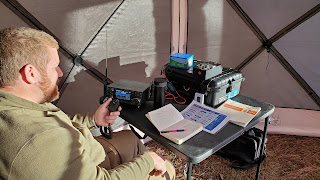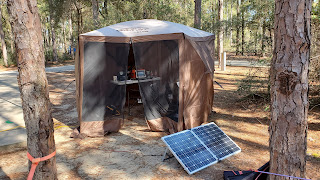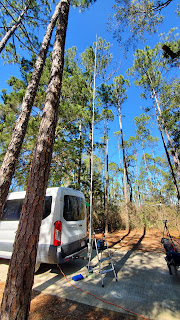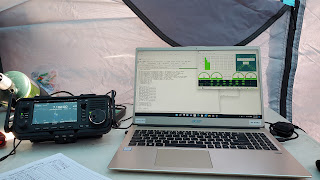Winter Field Day 2022 was the last weekend in January
1/29 thru 1/30 and several local hams Greg N4KGL, Daniel K4MDA, Scott KF7MYF,
Frank KC8VKA, and I camped out at Pine Log State Forest Sand Pond Campground
for the event. The forecast looked like
we were in for a cold weekend, but fortunately, there was no rain in the
forecast. But, I guess that’s what
Winter Field Day is all about. Actually,
I prefer to camp in cold weather, but honestly this weekend came pretty close
to my limit. Especially since I camp in
the back of a pickup truck. Sure, I had
a heated blanket, and it surely beats a tent, but getting out of bed when it’s
too cold isn’t exactly enjoyable first thing in the morning. Fortunately, there is always hot coffee.
I arrived Friday afternoon around 3:30 and went ahead and
set up my tent. This was new to me. Well, sort of. I have had a 10ft x10ft popup canopy for a
few years now and had a wall kit to give some protection from the wind, but it
was always difficult to set up. For this
event, I used my newly purchased camping cube.
This attaches to the underside of the same canopy I had used in the
past, but not only has 4 walls, but a floor and ceiling and does a better job
of keeping out the drafty winter wind. I
brought along a space heater since the campground has electrical and this
really helped the inside of the cube stay warm.
Later in the evening, a couple of us just sat around my
propane fire pit and chatted. The WFD
event did not start until 1pm Saturday local time, so we did not have the
radios set up yet. Dinner was uneventful
and not filmed. I just had one of those freeze-dried
Mountain House chili mac meals. Once we
all decided to turn in, I retreated to my truck bed accommodations and watched
a couple of episodes of Star Trek on the tablet before falling asleep. That night it cooled off to around 32 degrees
F and inside the camper shell in the truck bed using an electric blanket, I
stayed quite comfortable.
The next morning, I got up around 7am. It was chilly, but nothing warms you up like
a nice hot cup of coffee. After a couple
of cups of coffee, I got breakfast going.
Since Carla was unable to come, I only had to cook for myself. Unfortunately, I forgot a few things for
breakfast. I usually enjoy eggs and
Conecuh sausage for breakfast. If you
have never had Conecuh sausage, I highly recommend it. To my dismay, I left the sausage in the
freezer at the house. So, I had eggs and
hot dogs. It’s a meat right. Well, it’s some sort of meat anyway. I chopped up some yellow bell pepper, onions,
mushrooms to mix in the eggs and sprinkled some cheese on top. It was actually quite good despite the lack
of sausage.
Around 10am, I began setting up the station. First, I put up the antenna. My choice for the event was the SotaBeams
Bandhopper linked dipole. The one I use
is the 20/30/40-meter option. I spend
most of my time on 20 and 40 meters anyway, so this is always a good
option. If I wanted to work other bands,
I do have an Elecraft T1 tuner I could use.
It’s not ideal to tune the dipole because it’s not as efficient, but it
has worked in the past. For power I have
a Bioenno 120-watt solar panel that feeds my Bioenno 40 AH battery. Although we had a lot of shade in the
campground, this provides plenty of power to run my station, laptop, and keep
my accessories powered over the weekend.
The radio is the Icom IC-705.
I’ve already mentioned the tuner I use, the Elecraft T1. It is a tiny tuner, about the size of a deck
of cards and runs off a 9-volt battery. To
run the digital modes and the logging software I have an Acer laptop with an 8th
Gen I5 Processor. It has been a great
laptop and has more than enough power to run the software needed. My only complaint about the laptop stems from
my decision to upgrade it to Windows 11.
Well, that’s a story for another time.
Getting the radio set up and connected to FLDIGI was a
breeze and went off without a hitch. Well,
that’s a lie. I find that often things are not as easy as they should be. The last time I used this software was with
my FT-817 and getting the settings to work with the IC-705 took some
fiddling. I was running an older version
of FLDIGI/FLRIG that did not support the IC-705. It would work if I selected IC7300 and
changed some settings in the 705. I
decided to download the latest version of FLRIG and found that the IC705 is now
listed in the transceiver list eliminating the need to change the 705’s
settings. I was still fiddling with the
software/radio interface when the event started.
About 45 minutes into the event, I logged my first QSO with a station in Ontario, Canada. I got a few more QSOs into the logbook, then went around visiting. Daniel, K4MDA was my neighbor, and I spent some time in his camp as he operated at his station. He was using an Icom IC-7300 paired with a Wolf River Coil.
I think a big part of the event was the socializing. I enjoyed seeing what other hams had brought and set up. Speaking of other hams, Greg N4KGL was my neighbor on the other side of me. He was also using an Icom IC-7300. His antenna of choice was a wire antenna in an inverted-L running into the Icom AH-4 tuner. He had a SotaBeams Bandhopper as well as a backup antenna.
A few sites down was Scott, KF7MYF. He was operating a Kenwood TS-2000 and a multiband MFJ antenna similar to a G5RV. He was doing well with PSK and CW using FLDIGI.
Next to Scott, was Frank, KC8VKA. He did not do much operating, but he had an impressive collection of radio go-boxes and portable antennas, the most impressive of which was a 50 foot antenna on the trailer hitch mount of his van. Frank was the go-to guy for information as there were many newer hams that were interested in what was going on.
Later that evening, I cooked up a steak, asparagus, and some sauteed mushrooms, garlic, and onions on the Coleman stove with a cast iron griddle. This is one of my favorite meals when camping and you can bet that if I am camping, this is on the menu one of those nights. I went on and logged a few more QSOs but after 8pm the temperatures were dropping quickly, and I ended up turning in around 9pm.
I
woke up the next morning to 26 degrees at 6am.
Fortunately, the heated blanket did the trick and kept me comfortable
throughout the night. I got the space
heater fired up in the camping cube immediately. I even brought the Coleman camp stove inside
the cube to get the coffee going. I
opened the windows a bit to keep the carbon monoxide from building up since
there is a big warning on the stove.
Better safe than sorry. We had
been coordinating band usage via 2 meters so that we did not interfere with one
another, but since it looked like I was the first up and on the radio, I had
free range of the bands. 40 meters was
hopping and I enjoyed calling CQ and having quite a few people respond. My neighbor, Daniel and his wife headed out
early. He actually had packed up mostly
the night before. After things warmed up
a bit, I did a little more visiting around the campground. Most of us were starting to pack things up
and eventually Greg N4KGL was the only one left operating.
In
the end, I had only 31 contacts. But, as
I was telling others, to me it’s not about how many QSOs I get in the
logbook. It is more about the experience. Camping, socializing, setting up the
equipment, testing said equipment, trying different modes or whatever. To me, that is where I get the
enjoyment. I had a great time camping
with these hams. I enjoyed chatting and
seeing what others brought and I certainly will be looking forward to our next
adventure out.
73, --Bob























